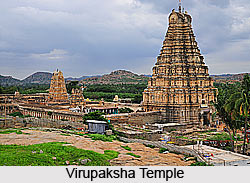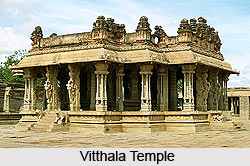 Hampi in Karanataka, now in ruins, was once the capital of the Vijayanagara Empire. It brought about a renaissance of art and culture, as it defended the region against the plundering armies. Much of Vijayanagara is now in ruins, as when the rulers were defeated at the hands of the invaders at the battle of Talikota in the 16th century, most of the marvellous structures and edifices were systematically destroyed.
Hampi in Karanataka, now in ruins, was once the capital of the Vijayanagara Empire. It brought about a renaissance of art and culture, as it defended the region against the plundering armies. Much of Vijayanagara is now in ruins, as when the rulers were defeated at the hands of the invaders at the battle of Talikota in the 16th century, most of the marvellous structures and edifices were systematically destroyed.Religious buildings are scattered about in small units in Hampi, each with its own importance and function. Perhaps one of the reasons for this change was the terrain of the area, with the plan of the city following the lay of the land. The temple architecture throughout is based on the traditional Hindu style and some of them followed traditions derived from other dynasties. Each dynasty that ruled the Vijayanagara Empire left its mark at Hampi. The Vijayanagara style of architecture relied heavily on the availability of natural resources, namely granite, which was the material used primarily by the rulers of Sangama dynasty. Other dynasties employed the softer schist rock, suitable for ornate carvings.
The temples of Hampi are famous for their large dimensions, florid ornamentation, both in painting and carving, majestic pillars, magnificent pavilions and a great wealth of religious and mythological depictions. Some of the temples of Hampi have derived inspiration from Indian scriptures namely the Ramayana and the Mahabharata.
One of the most important temples of Hampi is the Virupaksha Temple. The existence of the Virupaksha temple in the twelfth century is also proved by the inscription of AD 1199, inscribed on a finely polished schist slab, now the Durga devi temple, which refers to a grant of land made to seven hundred Brahmans of Hampi and for the worship of the deities of the place such as Virupaksha, Hampa devi, Bhairava etc. As per an inscription on a slab that is found in the northern gopura of the Virupaksha temple, it has been proved that the temple continued to be of significance in the thirteenth century. The existence of the ‘chattra’ and the Brahmans connected with the temple, points to the fact that the Virupaksha temple was already a centre not only of religious activities, but also of charitable and scholarly pursuits. It was with the establishment of the Vijayanagara kingdom and its capital at Hampi, that the Virupaksha cult gained immense popularity. The five sons of Sangama dynasty adopted Virupaksha as their kula-devata (family deity) as is clearly revealed in an epigraph, dated AD 1347, of Marappa, one of the five, in which Virupaksha is described as the family god of the sons of Sangama. This tradition was continued by the entire Sangama dynasty. The dynasty, the capital city and the kingdom were placed under the special protection of Virupaksha.
 Another most important temple of Hampi, which was built in the 15th century AD, is the Vitthala temple which is located near the Tungabhadra River. This temple is meticulously elaborated with decorative details and the shrine of Vitthala - Vishnu is placed here. The architecture of this temple is vivid and artistically projected with granite. This temple houses the famous Stone Chariot which is basically a shrine that is structured in the temple chariot form. Including this, an image of Garuda, the vehicle of Lord Vishnu, is also enshrined.
Another most important temple of Hampi, which was built in the 15th century AD, is the Vitthala temple which is located near the Tungabhadra River. This temple is meticulously elaborated with decorative details and the shrine of Vitthala - Vishnu is placed here. The architecture of this temple is vivid and artistically projected with granite. This temple houses the famous Stone Chariot which is basically a shrine that is structured in the temple chariot form. Including this, an image of Garuda, the vehicle of Lord Vishnu, is also enshrined.Inside the Vijayavittala Temple complex, the Stone Chariot deserves getting special attention. The chariot is a miniature temple. Though some believe it is carved out of a single rock, it is not the case. It resembles the temple chariots or rathas in which the idols of the temple are taken out on a traditional procession.
A Jain temple, Kunthu Jinanatha that is built in AD 1385, is reckoned as the largest and the most imposing of the early group of temples. This temple, the contribution of Irugappa, a minister and general of Harihara II, is located in the south-western part of the ‘urban core’, outside the ‘royal centre’. An inscription of AD 1386 reveals the contribution of a Siva temple by a customs official near that of Narasimha. Even though this part of the ‘sacred centre’ had begun to assume importance in the religious life of the city, with a Shaiva shrine and a Vaishnava temple in close proximity to each other, the original religious area around the Virupaksha temple and Hemakuta hill still continued as a hub of religious activity, witnessing new constructions for, in AD 1398, a small temple to god Virupaksha was erected on the southern end of Hemakuta hill by two Brahmin brothers. Apart from these temples there are some other temples namely the Narasimha temple that continued to be a focus of constructional activity in the first decade of the fifteenth century. Narasimha temple is one of the temples located in Hampi, situated on the south bank of Tungabhadra River, but at a distance to the east of the cluster of Shaivite shrines in and around the Virupaksha temple and the Hemakuta group. A record within its enclosure, dated AD 1406, notes the construction of a temple for god Gopinatha. Another inscription shows that in AD 1410, the same donor constructed a mandapa for god Gopinatha and the goddess Mahalaksmi. This temple, which has a number of epigraphs referring to it, dating from AD1379 to AD 1410, appears to have received no further grants or additions after the latter date. Another temple of fifteenth century is the Ramachandra temple which is located in the heart of the ‘royal centre’. Though there is no clear foundational inscription to help date this temple, on the basis of other epigraphical as well as monumental evidence it can be assigned to the reign of Devaraya I. The Ramachandra temple is not only an architecturally interesting structure, but was also central to the town-planning of the city.
For more visit the link given below: